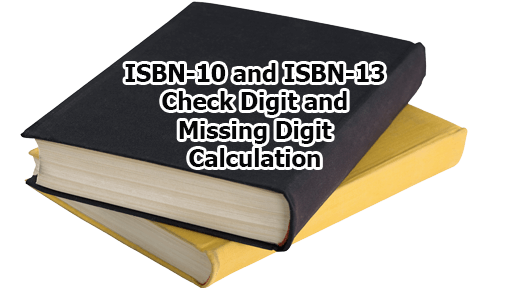ISBN-10 and ISBN-13 Check Digit and Missing Digit Calculation:
ISBN-10 and ISBN-13 are two different versions of the International Standard Book Number used for identifying books and other monographic publications. Both versions contain a check digit, which is used to verify the accuracy of the ISBN and prevent errors in the identification process. The check digit is calculated using a specific algorithm that takes into account the other digits in the ISBN. In addition, both versions may contain missing digits, which are represented by an “X” in the last position of the ISBN. Let’s explore the calculation of the check digit and the treatment of missing digits with example;
ISBN-10:
The ISBN-10 consists of 10 digits and is divided into four parts: the group identifier, the publisher code, the item number, and the check digit. The check digit is the last digit of the ISBN and is used to ensure the accuracy of the ISBN.
Let’s take an example of an ISBN-10: 0-13-235089-2
In this example, the group identifier is “0,” the publisher code is “13,” the item number is “235088,” and the check digit is “2.”
To calculate the check digit, we use the following formula:
(10 – ((d1 x 1) + (d2 x 2) + (d3 x 3) + … + (d9 x 9)) mod 10)
Using the example above, we would first multiply the first nine digits by their respective weights, then add up the products:
(0 x 1) + (1 x 2) + (3 x 3) + (2 x 4) + (3 x 5) + (5 x 6) + (0 x 7) + (8 x 8) + (9 x 9) = 209
We then take the sum and perform the mod 10 operation:
209 mod 10 = 9
Finally, we subtract the result from 10 to obtain the check digit:
10 – 9 = 1
Therefore, the ✅ correct check digit for this ISBN-10 is “1.”
Now let’s take an example of an ISBN-10 with a missing digit: 0-201-6X111-X
The ISBN-10 formula is:
∑(𝑑1×10 + 𝑑2×9 + 𝑑3×8+ ⋯ + 𝑑9×2 + 𝑑10×1) ≡ 0 (mod 11)
Given 0-201-6X111-X, let’s assign the known digits:
0, 2, 0, 1, 6, X, 1, 1, 1, X
Step 1: Compute the Weighted Sum
(0×10) + (2×9) + (0×8) + (1×7) + (6×6) + (X×5) + (1×4) + (1×3) + (1×2) + (X×1)
=0 + 18 + 0 + 7 + 36 + (X×5) + 4 + 3 + 2 + X
=70 + 6X
Step 2: Solve for 𝑋
The total must be divisible by 11
(70+6X) ≡ 0 mod 11
Testing values:
- If X = 3, then 70 + 6(3) = 88, which is divisible by 11.
Thus, X=3, and the complete ISBN-10 is:
0−201−63111−3
✅Correct check digit 3
ISBN-13:
The ISBN-13 consists of 13 digits and is divided into five parts: the GS1 prefix, the group identifier, the publisher code, the item number, and the check digit. The check digit is the last digit of the ISBN and is used to ensure the accuracy of the ISBN.
Let’s take an example of an ISBN-13: 978-0-13-235088-4
In this example, the GS1 prefix is “978,” the group identifier is “0,” the publisher code is “13,” the item number is “235088,” and the check digit is “4.”
To calculate the check digit, we use the following formula:
(10 – ((d₁ x 1) + (d₂ x 3) + (d₃ x 1) + … + (d₁₂ x 3)) mod 10)
Using the example above, we would first multiply the first 12 digits by their respective weights, then add up the products:
(9 x 1) + (7 x 3) + (8 x 1) + (0 x 3) + (1 x 1) + (3 x 3) + (2 x 1) + (3 x 3) + (5 x 1) + (0 x 3) + (8 x 1) + (8 x 3) = 96
We then take the sum and perform the mod 10 operation:
96 mod 10 = 4
Finally, we subtract the result from 10 to obtain the check digit:
10 – 4 = 6
Therefore, the ✅ correct check digit for this ISBN-13 is “6.”
Now let’s take an example of an ISBN-13 with a missing digit: 978-0-201-6X111-X
The ISBN-13 formula is:
∑(d₁×1 + d₂×3 + d₃×1 + d₄×3 + ⋯ + d₁₂×1) + d₁₃ × 1 ≡ 0 (mod 10)
Given 978-0-201-6X111-X, let’s assign the known digits:
9, 7, 8, 0, 2, 0, 1, 6, X, 1, 1, 1, X
Step 1: Compute the Weighted Sum
(9×1) + (7×3) + (8×1) + (0×3) + (2×1) + (0×3) + (1×1) + (6×3) + (X×1) + (1×3) + (1×1) + (1×3) + (X×1)
= 9 + 21 + 8 + 0 + 2 + 0 + 1 + 18 + X + 3 + 1 + 3 + X
= 66 + 2X
Step 2: Solve for 𝑋
The total must be divisible by 10:
(66+2X) ≡ 0 mod 10
Testing values:
- If X = 2, then 66 + 2(2) = 70, which is divisible by 10.
Thus, X = 2, and the complete ISBN-13 is:
978−0−201−62111−2
✅Correct check digit: 2
It is apparent that both ISBN-10 and ISBN-13 use a check digit to ensure the accuracy of the ISBN. To calculate the check digit, we multiply each digit by its weight, add up the products, perform the mod 10 operation, and subtract the result from 10. If there is a missing digit, we treat it as 10 when calculating the check digit.

Library Lecturer at Nurul Amin Degree College










